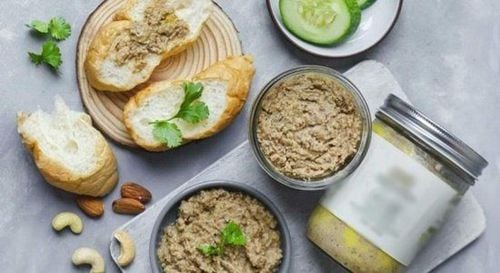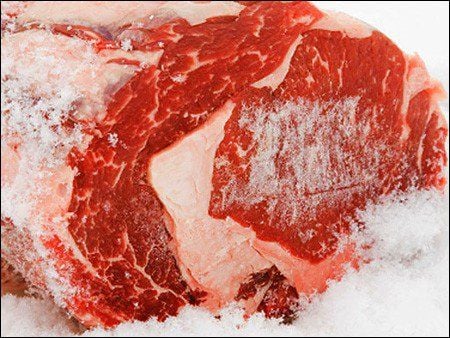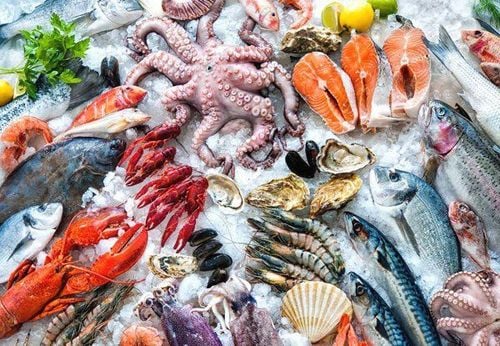This is an automatically translated article.
During the use and processing of meat and poultry, consumers have common questions about the water content of packaged meat when purchased at supermarkets or stores such as: Why is all this water in the packages? meat and poultry? Or is there a lot of water in the roast or is the dealer injecting water into the meat? This article will provide more of this information.
1. Moisture naturally occurs in meat and poultry
Meat and poultry consists of natural water, muscle, connective tissue, fat and bone. People eat meat for muscle. Water in poultry in particular and water in meat in general is about 75% (although different cuts may have more or less water) and 20% protein, the remaining 5% representing a combination of fats, carbohydrates and minerals. The percentage of water in meat can vary depending on the type of muscle, the type of meat, the season of the year, and the pH of the meat. Fat in meat is found both between muscles and within muscles. In both locations, fat contributes to the overall flavor and palatability of the meat.
2. Water content of meat and poultry
The amount of water in meat or the natural moisture present in meat and poultry can surprise consumers. A piece of rump meat has a water content of about 73% of the water before cooking. Similarly, after roasting, the water content of meat contains about 65%. The whole fryer contains 66% water before cooking and 60% afterwards. Lean meat and poultry contain more protein and less fat. Since water is also considered a component of protein but not fat, leaner cuts of meat contain more water by weight.
Whole fried chicken: Uncooked water content accounted for 66%, water content after cooking accounted for 60%; Chicken breast meat with skin: Uncooked water content accounted for 69%, water content after cooking accounted for 61%; Thigh meat or meat in other parts of chicken: Uncooked water content accounted for 66%, water content after cooking accounted for 59%; Beef butt 85% lean: The water content in uncooked accounted for 64%, the water content after cooking accounted for 60%; Beef butts 73% lean: Water content in uncooked accounted for 56%, water content after cooking accounted for 55%; Beef butt: Water content uncooked accounted for 73%, water content after cooking accounted for 65%; Whole beef tenderloin: Water content in uncooked accounted for 71%, water content after cooking accounted for 56%
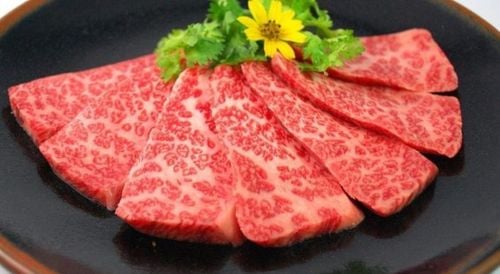
Lượng nước trong thịt hoặc độ ẩm tự nhiên có trong thịt và gia cầm có thể làm người tiêu dùng ngạc nhiên
3. Lean beef contains high water content
Most consumers are informed that beef today contains more water and also does not taste like it used to. One possible reason for this is that animals today were bred to be thinner. The meat of these animals is naturally leaner and contains more water. The fat content of meat can contribute to the flavor of a product, so leaner cuts of meat will taste different from fattier cuts of meat. Some of these thinner cuts are enhanced with a flavoring solution.
4. Growth of meat and poultry products
Currently, meat and poultry products with added flavoring solutions are provided by many stores or supermarkets. For example, pork chops can be packed with a solution of water, salt, and sodium phosphate - a solution that can add flavor and moisture to leaner meats. These food products also provide convenience to consumers by saving preparation steps, such as Beef Teriyaki Sauce. To avoid confusion in the consumer's food selection process, the presence of the flavoring solution must be indicated on the front of the package.
Enhanced or value-added meat and poultry products are raw products that contain flavor solutions added through marinating, needle injection, pickling, etc. The presence of flavoring solution and its strength shall be indicated as part of the product name, such as flavored chicken thighs with up to 10% solution or marinated steak with 6% flavor solution . The ingredients of the flavoring solution must be prominently identified on the product label. Usually, this information will be recorded on the main display or information board.
The labeling term is marinade that can only be used with a specific amount of solution. Marinated meats should not contain more than 10% solution; boneless poultry, not more than 8% solution; and poultry with bones, a solution not exceeding 3%.
In the case of enhanced products, solutions are added to meat or poultry, used for flavoring, seasoning and softening, intended to be treated as an added flavor as part of the product. Solutions are required by regulations and policies to be identified as part of the enhanced product name, and whether the solution is incorporated into the product or in a free-flowing form, it is considered as part of the product.
5. Natural products
All single ingredient meat and poultry qualify as natural. However, some products that are labeled natural may also contain a flavoring solution as long as the solution contains minimally processed ingredients and is not artificial; eg: natural flavoring. There is no limit to the amount of solution that can be added to products with a natural claim. All natural products must be accompanied by a brief statement explaining what the term natural means.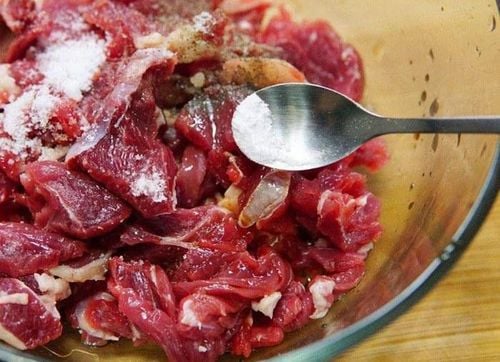
Thành phần dinh dưỡng chất béo của thịt có thể tạo nên hương vị của sản phẩm
6. Freezing Meat and Poultry
When meat and poultry are stored frozen, water - a natural component of all meats will turn into ice solid crystals. Water expands when it freezes. The sharp crystals push into surrounding tissues, rupturing cells. The water outside the cell membrane is frozen first. As such, it draws water from within the cell membrane. When it thaws, the original balance does not return to normal. Products that have been thawed will lose some of their natural elasticity. Water released during freezing seeps out of thawed meat and poultry into the packaging.
The faster meat and poultry freeze, the smaller the ice crystals will be. Smaller ice crystals will have less of an effect on the quality of the meat during defrosting. The product that is quickly frozen by the manufacturer will have superior quality compared to the fresh frozen product provided by the consumer.
7. Loss of moisture from meat and poultry
Meat and poultry transported from slaughter plants and processed in refrigerated trucks can be kept cold to -17 degrees Celsius. Although they may not be frozen solids, they are in the state they are. half frozen or frozen solid. Therefore, any moisture present in the product is retained in the tissue of the product.
Beef is usually ground when partially frozen. Because of the ice crystals present in frozen beef, there may be more liquid in it.
At the grocery store, products are displayed in refrigerators as cold as - 3 degrees Celsius. At this temperature, the product's cells will loosen"somewhat and some of the moisture will dissolve. out and seep out.
In household refrigerators set at 4°C or below, even more liquid will seep out of the product. The longer the product is left in the refrigerator, the more liquid is released from the muscle cells.
8. Meat and Poultry Packaging
Some meat and poultry products are vacuum packed to extend shelf life. The product is packaged in leak-proof and air-tight containers under vacuum conditions, and in some cases a specific gas is injected into the packaging to preserve flavor and quality. When the package is placed in the refrigerator, the vacuum remains active, extracting juices from the meat. Since these packages are airtight and leak-proof, juice will accumulate in the pack. In contrast, plastic-wrapped packaging, commonly used by most supermarkets, allows a certain amount to evaporate.
9. Some regulations help retain water in meat and poultry
Meat and poultry have natural moisture and may also contain moisture retained from processing after rearing. During processing, freshly slaughtered animals and their internal organs (heart, liver, kidneys, etc.) are chilled to cool them down to a safe temperature. Absorbed water used for treatment after discharge is considered as retained or absorbed water. If the carcass or parts have so absorbed water, the amount of water in % together with the terms retained water or absorbed water, (e.g. up to X% of water retained or can contain up to X% retained water or with absorbed water X% ) must be stated on the label.
Consumers can compare product labels for the presence of retained (or absorbed) water to ensure that comparable products are the same.
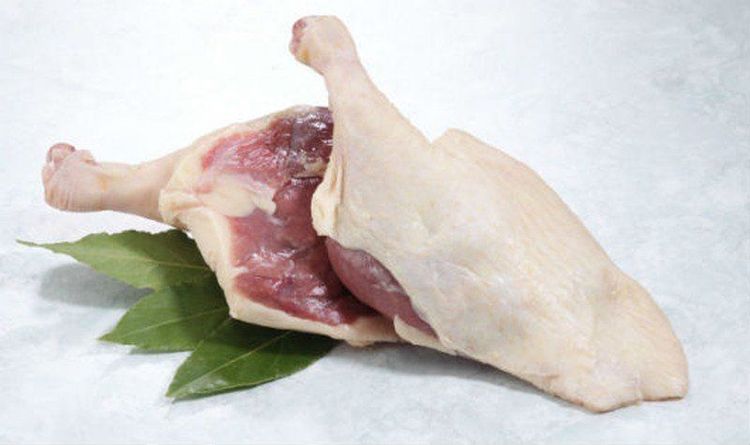
Gia cầm không được tiêm nước, nhưng một số nước được hấp thụ ở quá trình làm mát trong thùng nước lạnh lớn
10. Water retention in food products
10.1 Water retained in raw poultry products
Poultry are not injected with water, but some of the water is absorbed during cooling in a large cold water tank. The chill tank lowers the temperature of slaughtered birds and their gills (hearts, livers, gizzards, etc.). During this cooling process, turkeys and chickens will absorb some water, and this amount must be clearly stated on the product's label. It is not uncommon for poultry to claim 8 to 12% water retention on product labels.
10.2. Water retained in raw meat products
Beef is washed off during slaughter, but the small amounts of water used usually seep to the surface of the meat, do not bind to proteins or inside tissues, and quickly evaporate vapors or drips out. Meat processors will periodically bathe red carcasses to minimize moisture loss or shrinkage that occurs in the refrigerator prior to processing. Beef carcasses and parts thereof that are chilled in water during post-discard processing should be appropriately labeled with the residual water claim.
11. Cooking meat and poultry
In general, the higher the cooking temperature, the more moisture will be lost during cooking. It's not uncommon for roast beef to lose a third of its original size and weight when cooked over high heat or for too long.
Please dial HOTLINE for more information or register for an appointment HERE. Download MyVinmec app to make appointments faster and to manage your bookings easily.
Reference source: fsis.usda.gov



